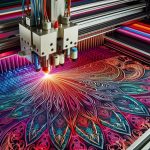Want to take your fabric designs to the next level? Choosing the right heat transfer paper can make all the difference. With so many options available, it's essential to know which one will truly make your fabrics stand out.
From vibrant colors to intricate details, the right heat transfer paper can elevate your creations to new heights. Let's explore the various types of heat transfer paper and find the perfect match for your unique projects.
Key Takeaways
- Inkjet Heat Transfer Paper and Laser Heat Transfer Paper offer excellent color reproduction and vibrant prints, making them ideal for capturing intricate details and ensuring image clarity.
- Dark Fabric Transfer Paper and Light Fabric Transfer Paper achieve vibrant and eye-catching designs on fabrics, but require different techniques and temperatures for proper ink adhesion.
- Printable Heat Transfer Vinyl provides durability and washability for long-lasting designs, with the option to choose between vinyl and paper for fabric enhancement.
- Sublimation Transfer Paper produces vibrant, high-quality prints with long-lasting durability, but is limited to light-colored fabrics and requires polyester or polymer-coated substrates.
Inkjet Heat Transfer Paper
You can achieve vibrant and detailed designs on your fabrics by using inkjet heat transfer paper. This type of paper is specifically designed for use with inkjet printers, allowing you to print your designs directly onto the paper using the printer's ink. When it comes to printing techniques, inkjet heat transfer paper offers excellent color reproduction and the ability to capture intricate details, making it an ideal choice for creating visually striking designs on fabric.
In terms of fabric compatibility, inkjet heat transfer paper can be used on a variety of materials including cotton, polyester, and blends. It's essential to consider the fabric composition when selecting inkjet heat transfer paper, as different papers are formulated to work best with specific fabric types. Additionally, it's crucial to follow the manufacturer's guidelines for heat transfer paper to ensure optimal results.
Mastering the use of inkjet heat transfer paper involves understanding the intricacies of printing techniques and selecting the right paper for the fabric you're working with. By honing these skills, you can elevate your fabric designs to new heights of creativity and quality.
Laser Heat Transfer Paper
When it comes to laser heat transfer paper, you can expect vibrant color reproduction that really makes your designs pop.
Not only that, but the prints are durable and long-lasting, ensuring that your creations stay looking fresh wash after wash.
Laser heat transfer paper is a reliable choice for achieving professional-quality results on your fabrics.
Vibrant Color Reproduction
For vibrant color reproduction on your fabrics, consider using laser heat transfer paper.
Laser heat transfer paper is known for its exceptional color fastness and print quality, ensuring that your designs stay vivid and sharp even after multiple washes.
When using laser heat transfer paper, you can expect excellent image clarity and precise detailing, resulting in striking designs that stand out on various fabric types.
This type of heat transfer paper is also compatible with a wide range of fabrics, allowing you to achieve vibrant color reproduction on cotton, polyester, blends, and more.
Whether you're creating custom apparel, promotional items, or personalized accessories, laser heat transfer paper offers the quality and vibrancy you need to make your designs truly pop.
Durable and Long-Lasting
To ensure your designs maintain their vibrancy and sharpness for an extended period, laser heat transfer paper is recognized for its exceptional durability and long-lasting color retention. Laser heat transfer paper offers excellent fabric compatibility and heat resistance, making it suitable for a wide range of materials, including cotton, polyester, and blends. Its ability to withstand high temperatures during the transfer process ensures that the colors remain vivid and the designs stay intact even after multiple washes. Additionally, laser heat transfer paper is cost-efficient and has a minimal environmental impact, making it a sustainable choice for businesses. Its long-lasting performance and eco-friendly characteristics make it a preferred option for those seeking quality and durability in their heat transfer projects.
| Fabric Compatibility | Heat Resistance | Environmental Impact |
|---|---|---|
| Cotton, Polyester, Blends | Withstands high temperatures | Cost-efficient, Minimal impact |
Dark Fabric Transfer Paper
With dark fabric transfer paper, you can achieve vibrant and eye-catching designs on your fabrics, making them stand out in any setting. Before starting the transfer process, ensure that your printer's temperature settings are appropriate for dark fabric transfer paper. Typically, these papers require higher temperatures than their light fabric counterparts to ensure the ink adheres properly. Additionally, consider the fabric compatibility of the paper to ensure the best results. Dark fabric transfer paper works best on materials such as cotton, polyester, and blends with a high polyester content.
When selecting images for dark fabric transfer paper, opt for high-resolution designs to achieve the best outcome. The printing process is crucial in ensuring that the ink is applied evenly and with precision. Be sure to follow the manufacturer's instructions regarding printer settings and image transfer techniques. This will help you achieve professional-looking results on dark fabrics.
Dark fabric transfer paper opens up a world of possibilities for creating unique and striking designs on your fabrics. By paying attention to temperature settings, fabric compatibility, image resolution, and the printing process, you can ensure that your dark fabric transfers stand out with vibrancy and clarity.
Light Fabric Transfer Paper
How effectively can light fabric transfer paper enhance the vibrancy of your fabric designs?
Light fabric transfer paper can significantly enhance the vibrancy of your fabric designs, offering a crisp and vivid appearance. When considering this type of transfer paper, it's essential to understand the various factors that can impact its effectiveness. Here are some key points to consider:
- Heat Press Techniques: Utilizing the correct heat press techniques is crucial for achieving optimal results with light fabric transfer paper. Understanding the ideal temperature, pressure, and duration for the heat press is essential.
- Fabric Compatibility: Not all fabrics are compatible with light fabric transfer paper. It's important to select fabrics that are suitable for use with this type of transfer paper to ensure the best outcomes.
- Iron-On Application: Light fabric transfer paper often involves an iron-on application method. Mastering the iron-on process is essential for achieving professional and long-lasting results.
- Image Resolution: High image resolution is vital for ensuring that the transferred design appears sharp and detailed on light fabrics. Paying attention to image quality is crucial for achieving the desired outcome.
When using light fabric transfer paper, mastering these aspects will contribute to the overall quality and vibrancy of your fabric designs.
Printable Heat Transfer Vinyl
When it comes to enhancing your fabrics with heat transfer designs, choosing between vinyl and paper options can make a significant difference in the outcome.
The durability and washability of printable heat transfer vinyl are key factors to consider when aiming for long-lasting designs.
Additionally, the color vibrancy and quality achieved with heat transfer vinyl can truly make your fabrics stand out.
Vinyl Vs. Paper Options
You can enhance your fabric designs with either vinyl or paper options when using printable heat transfer vinyl. Both options offer unique advantages and considerations to keep in mind.
- Durability: Vinyl is known for its long-lasting durability, making it suitable for items that will undergo frequent washing and heavy use.
- Breathability: Paper options are often more breathable than vinyl, making them a better choice for fabrics that need to retain their softness and flexibility.
- Detail: Vinyl allows for intricate detailing and fine lines in designs, making it ideal for intricate and complex designs.
- Cost-effectiveness: Paper options are generally more affordable, making them a great choice for cost-conscious projects.
- Application versatility: Vinyl is suitable for a wide range of fabrics, including those with stretch, while paper options may have limitations on the types of fabrics they can be applied to.
Durability and Washability
For durable and washable results, consider using printable heat transfer vinyl on your fabrics. Printable heat transfer vinyl offers excellent durability, making it suitable for fabrics that undergo frequent washing and wearing.
The vinyl adheres firmly to the fabric, ensuring that the design remains intact even after multiple washes. This type of heat transfer material is also versatile, allowing you to apply it to various fabric textures without compromising its durability.
Additionally, printable heat transfer vinyl is known for its environmental impact, as it often contains fewer harmful chemicals compared to other heat transfer options. Its ability to withstand regular washing, maintain fabric texture, and minimize environmental impact makes printable heat transfer vinyl an ideal choice for creating long-lasting, vibrant designs on your fabrics.
Color Vibrancy and Quality
To ensure that your designs maintain their vibrant colors and high quality, printable heat transfer vinyl offers a reliable solution for achieving long-lasting and visually striking results on your fabrics. With its exceptional color vibrancy and durability, this material allows you to create eye-catching designs that withstand frequent washing and maintain their original brilliance.
- Fabric compatibility and printing techniques play a crucial role in achieving optimal color vibrancy and quality.
- Color fastness ensures that your designs resist fading and maintain their vividness over time.
- High image resolution is essential for capturing intricate details and vibrant colors in your designs.
- Understanding the fabric's composition is key to achieving the best color vibrancy and quality.
- Utilizing the appropriate printing techniques can enhance the overall vibrancy and quality of your designs.
Sublimation Transfer Paper
When using sublimation transfer paper, ensure that your fabric design will have vibrant colors and long-lasting durability. Sublimation printing techniques offer a high level of color vibrancy and precision, making it an excellent choice for fabric customization options. Whether you're creating custom apparel, home décor, or promotional items, sublimation transfer paper can help your designs stand out and last.
| Advantages | Considerations |
|---|---|
| Produces vibrant, high-quality prints | Requires polyester or polymer-coated substrates |
| Offers long-lasting durability | Limited to light-colored fabrics |
| Allows for intricate details and gradients | Not suitable for natural fabrics like cotton |
| Low maintenance and easy to use | Sublimation inks can be expensive |
Sublimation transfer paper is a versatile option for those looking to achieve professional-quality fabric designs. By understanding the advantages and considerations of this technique, you can make informed decisions about incorporating sublimation printing into your fabric customization projects.
Glitter Heat Transfer Paper
You can enhance your fabric designs with the shimmering effects of glitter heat transfer paper. Glitter heat transfer paper adds a touch of sparkle and glam to your custom designs, making them stand out in a crowd. When using glitter heat transfer paper, consider the following:
- Glitter application techniques, creative designs: Experiment with different application techniques to achieve unique and creative designs, such as layering glitter heat transfer paper with other types of heat transfer paper for added dimension.
- Fabric compatibility: Ensure that the fabric you're using is compatible with glitter heat transfer paper. Fabrics with a smooth and flat surface, such as cotton, polyester, and blends, work best with glitter heat transfer paper.
- Heat press settings: Set your heat press to the recommended temperature and pressure for glitter heat transfer paper to ensure proper adhesion and vibrant colors.
- Design considerations: Keep in mind that fine details and small text may not translate well with glitter heat transfer paper due to its textured surface.
- Post-application care: Follow the manufacturer's guidelines for washing and caring for fabrics adorned with glitter heat transfer paper to maintain the design's longevity and sparkle.
Eco-Friendly Heat Transfer Paper
Considering sustainability in your fabric designs? Using eco-friendly heat transfer paper offers a greener option for adding vibrant and durable designs to your fabrics. Sustainable printing options are becoming increasingly important in the fashion and textile industry.
Eco-friendly heat transfer paper is designed to minimize environmental impact, making it an ideal choice for conscious creators. This type of heat transfer paper is often made from recycled materials and uses water-based inks, reducing the use of harmful chemicals and decreasing energy consumption during the production process.
When incorporating eco-friendly heat transfer paper into your fabric designs, you can be confident that you're making a positive choice for the environment. Not only does it allow you to create stunning, high-quality designs, but it also aligns with the growing demand for sustainable and ethical practices in the industry.
Frequently Asked Questions
Can Heat Transfer Paper Be Used on Any Type of Fabric, or Are There Limitations Based on Fabric Content or Weave?
When using heat transfer paper, consider fabric compatibility and weaving limitations. Heat transfer paper may not adhere well to certain fabrics or weaves, affecting the quality of the transfer. Always test on a small area first.
What Are the Best Practices for Washing and Caring for Garments or Fabrics That Have Been Decorated With Heat Transfer Paper?
To maintain fabric durability and vibrant heat transfer paper designs, follow these washing instructions: Turn garments inside out, use cold water, gentle cycle, and mild detergent. Avoid bleach and fabric softeners. Air dry or tumble dry on low heat.
Are There Specific Heat Press Settings or Techniques That Should Be Used for Different Types of Heat Transfer Paper?
When using heat transfer paper, ensure to adjust heat press settings for temperature variations and fabric compatibility. Vary pressing techniques based on design complexity, and always follow safety precautions and environmental impact considerations.
Can Heat Transfer Paper Be Used to Create Multi-Color or Complex Designs, or Are There Limitations to the Level of Detail That Can Be Achieved?
When using heat transfer paper, the level of detail in multi-color designs can be impressive, but there are limitations. Complex designs may require specialized techniques. Experimenting with different papers and methods can help achieve desired results.
Are There Any Safety or Environmental Considerations to Be Aware of When Using Different Types of Heat Transfer Paper, Such as the Release of Harmful Fumes During the Transfer Process?
When using different types of heat transfer paper, it's important to consider safety precautions and environmental impact. Some papers may release harmful fumes during the transfer process, posing health concerns. Be mindful of these factors.
- Phase-Change Materials: The Science Behind Smart Fabrics - July 24, 2024
- Graphene-Enhanced Fabrics: What to Expect - July 24, 2024
- Nanotechnology: Enhancing Fabric Performance - July 24, 2024








